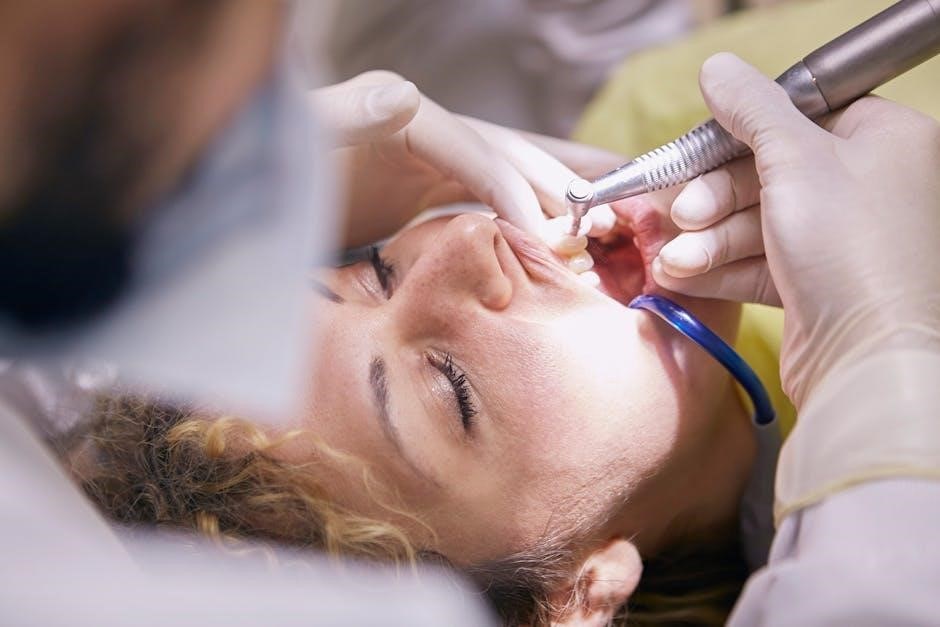Boiling a mouthguard is a common method to create a custom fit for dental protection. It involves heating the device to soften it for shaping around teeth, ensuring comfort and proper coverage during sports or teeth grinding. This process is essential for achieving a snug, secure fit that provides optimal protection and prevents injuries.
What is a Boil-and-Bite Mouthguard?
A boil-and-bite mouthguard is a customizable dental appliance designed to fit securely over teeth for protection during sports or teeth grinding. Made from thermoplastic material, it softens when boiled, allowing users to bite down and mold it to their unique dental structure. This process creates a snug, personalized fit that provides superior comfort and protection compared to generic mouthguards. The boil-and-bite method is popular for its simplicity and cost-effectiveness, offering a balance between professional-grade customization and at-home convenience. Proper fitting ensures optimal performance and safety for the wearer.
Why Boil a Mouthguard?
Boiling a mouthguard softens the thermoplastic material, making it pliable for molding. This step is crucial for creating a custom fit that adapts to the user’s teeth and mouth shape. Boiling ensures the mouthguard conforms evenly, providing maximum comfort and protection. Without boiling, the mouthguard remains rigid and unable to mold properly, leading to a poor fit and reduced effectiveness. The boiling process is essential for achieving the snug, secure fit necessary for dental protection during sports or teeth grinding, ensuring optimal performance and user safety.
Importance of Proper Fitting
A properly fitted mouthguard is essential for effective protection and comfort. It ensures even distribution of impact forces, preventing injuries to teeth and gums. A poorly fitted mouthguard can shift during use, reducing its protective capabilities and potentially causing discomfort or irritation. Proper fitting also enhances breathing and speaking, making it more comfortable for the user during activities. Ensuring a snug, customized fit through the boiling process is crucial for maximizing the mouthguard’s performance and longevity, providing peace of mind for athletes and individuals with teeth grinding habits.

Preparation for Boiling a Mouthguard
Preparation involves gathering materials, reading instructions, and preparing boiling water. Ensure all items are ready to avoid delays during the process. Proper preparation is key to success.
Gathering Necessary Materials
To boil a mouthguard, you’ll need a large pot for boiling water, a stove or heat source, tongs or a spoon for handling the mouthguard, a timer, a bowl of cold or ice water for cooling, a clean, dry surface for shaping, and a towel for drying. Ensure you have the mouthguard itself and any additional accessories like straps. Having these materials ready will streamline the process and ensure safety and effectiveness.
Reading the Manufacturer’s Instructions
Before boiling a mouthguard, read the manufacturer’s instructions carefully. Each mouthguard may have specific guidelines, such as recommended boiling times, temperatures, and cooling procedures. The instructions often outline steps to ensure proper fit and comfort. They may also include tips for avoiding common mistakes, like overheating or improper shaping. Following these guidelines helps prevent damage to the mouthguard and ensures it molds correctly to your teeth and gums. Ignoring instructions can lead to a poor fit or reduced protection. Always review the provided information thoroughly before starting the boiling process.
Preparing Boiling Water
To prepare boiling water for your mouthguard, fill a pot with enough clean water to fully submerge the guard. Use a stove or microwave to heat the water until it reaches a rolling boil. Ensure the water is hot but not excessively boiling, as extreme temperatures can damage the mouthguard material. Avoid using water from a kettle, as it may be too hot. If the water is too hot, let it cool slightly before proceeding. Do not add salt or other substances, as plain water is sufficient for the boiling process. Properly heated water is essential for molding the mouthguard correctly.

The Boiling Process
The boiling process involves heating water to the correct temperature, submerging the mouthguard, and timing the process. Ensure the water is not too hot, and follow the instructions carefully to achieve a proper fit. Proper technique is crucial for a snug and comfortable mouthguard.
Heating Water to the Correct Temperature
Heating water to the correct temperature is essential for boiling a mouthguard. Fill a pot with enough water to fully submerge the mouthguard. Bring the water to a boil, then reduce the heat to a simmer. Use a thermometer to ensure the water reaches the recommended temperature, typically between 160°F and 180°F. Avoid overheating, as this can damage the mouthguard material. For best results, follow the manufacturer’s guidelines for temperature and timing. Proper heating ensures the mouthguard softens evenly, allowing it to mold correctly to your teeth and gums. This step is crucial for achieving a comfortable and secure fit;
Submerging the Mouthguard
Once the water has reached the correct temperature, carefully submerge the mouthguard into the water. Ensure it is fully covered by the water to allow even softening. Avoid agitating the water excessively, as this could cause the mouthguard to move out of position. Use a pair of tongs or a slotted spoon to gently place and hold the mouthguard underwater if necessary. Keep it submerged for the recommended time, usually 1-2 minutes, to soften the material without overheating. Proper submerging ensures the mouthguard molds evenly when bitten into, providing a secure and comfortable fit.
Timing the Boiling Process
Timing is crucial when boiling a mouthguard. Most mouthguards require boiling for 1-2 minutes, depending on the brand. Exceeding the recommended time can cause overheating, leading to distortion or a loose fit. Use a timer to ensure accuracy. After boiling, remove the mouthguard from the water with tongs or a slotted spoon. Allow it to cool slightly before molding. Proper timing ensures the material softens adequately for shaping without becoming too fragile. If undercooked, the mouthguard may not mold properly; if overcooked, it may lose structural integrity. Always follow the manufacturer’s guidelines for optimal results.

Post-Boiling Steps
After boiling, remove the mouthguard with tongs, let it stand for a few seconds, and gently place it in your mouth to shape it properly.
Removing the Mouthguard from Water
Use tongs or a slotted spoon to carefully lift the mouthguard from the boiling water. Avoid using your hands to prevent burns. Gently shake off excess water, then let it cool for a few seconds. Do not rush this step, as the mouthguard will still be hot and pliable. Ensure it’s not too hot before proceeding to the next step. Proper removal prevents burns and ensures the mouthguard is ready for shaping. Always prioritize safety when handling hot materials.
Allowing Water to Stand
After boiling, let the water stand for 10–15 seconds to slightly cool the mouthguard. This brief wait reduces the risk of burns when handling it. Use tongs or a slotted spoon to carefully remove the mouthguard from the water. Excess water should drip off naturally. Avoid squeezing or pressing the mouthguard while it’s still hot, as this could distort its shape. Allowing the water to stand ensures the mouthguard is manageable for the next steps without compromising its pliability. This step is crucial for safe handling and achieving an accurate fit.
Placing the Mouthguard in the Mouth
Once the mouthguard has slightly cooled, carefully place it into your mouth, ensuring it covers your upper teeth and aligns with your bite. Use a mirror to help position it correctly. Gently bite down to start molding the guard to your teeth. Make sure it’s not too hot to avoid discomfort or burns. The mouthguard should feel snug but comfortable. Proper placement ensures it protects your teeth and stays in place during activities. If it feels misaligned, remove it and reposition before biting down again. This step is critical for achieving a proper, protective fit.
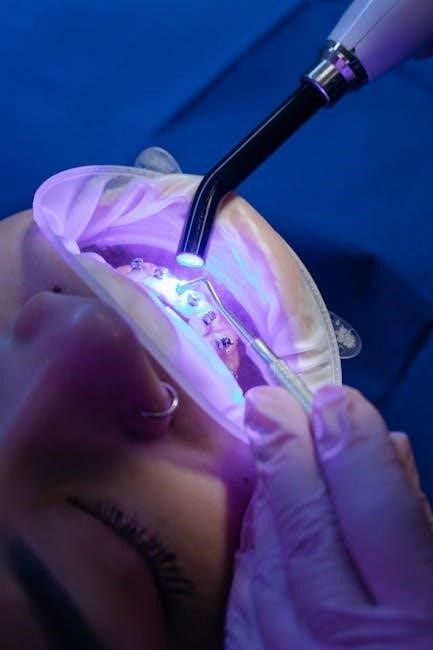
Shaping the Mouthguard
Shaping ensures a custom fit. After boiling, bite down firmly to mold the guard to your teeth. Hold for 30 seconds to set the shape properly.
Biting Down to Mold the Guard
Biting down firmly on the mouthguard after boiling shapes it to your teeth and gums. Ensure a steady bite for 20-30 seconds to create an accurate impression. Avoid moving the mouthguard during this process, as it can misshape the fit. Once set, remove it and let it cool slightly before checking the fit. If necessary, repeat the process for adjustments, ensuring the guard feels snug but not overly tight. Proper molding ensures maximum protection and comfort during use.
Ensuring a Tight Fit
A tight fit is crucial for protection and comfort. After molding, check if the mouthguard stays in place without shifting. It should snugly cover your teeth and gums. If it feels loose, reheat and repeat the molding process. For a tighter fit, gently press the guard against your teeth while it’s still warm. Avoid over-tightening, as this can cause discomfort. A proper fit ensures maximum protection during sports or activities. If unsure, consult the manufacturer’s guidelines for additional adjustments. A well-fitted mouthguard enhances performance and safety.
Adjusting for Comfort
After molding, fine-tune the mouthguard for optimal comfort. If it feels too tight, carefully trim excess material with sharp scissors or a file, ensuring not to weaken the structure. For areas pressing uncomfortably on gums, gently smooth the edges using fine-grit sandpaper. Avoid overheating, as it can distort the shape. If the fit remains unsatisfactory, consider reheating the mouthguard slightly to make adjustments. Always follow the manufacturer’s guidelines to maintain protection. A comfortable fit enhances wearability and performance during sports, ensuring both safety and ease of use.
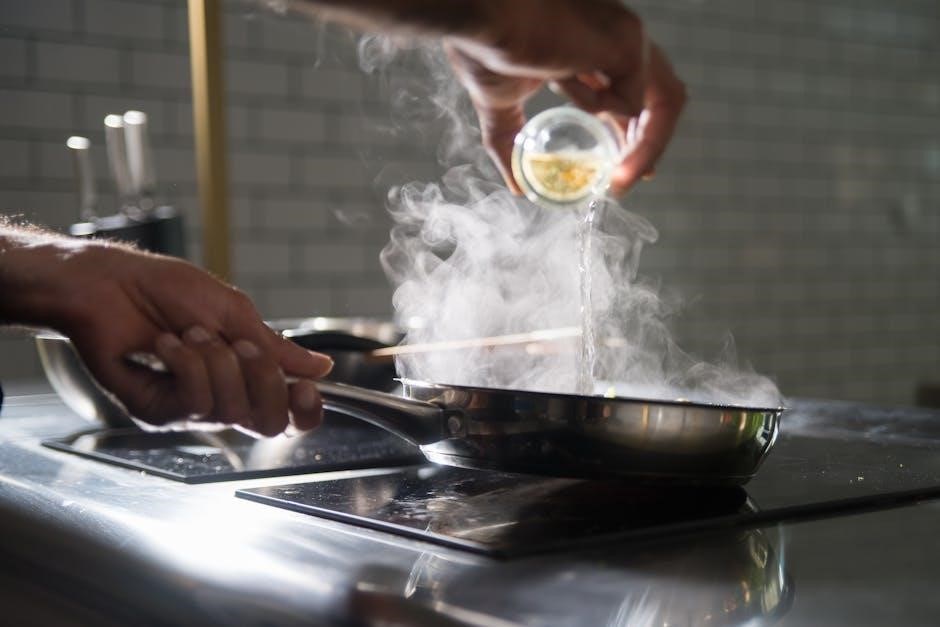
Cooling and Setting
After shaping, submerge the mouthguard in ice water to cool rapidly. Let it set at room temperature to harden. Check the fit post-cooling for comfort.
Using Ice Water for Rapid Cooling
After boiling, immediately submerge the mouthguard in a bowl of ice water to stop the cooling process. This step is crucial to prevent the material from hardening too quickly, ensuring it retains the mold of your teeth. Fill a large bowl with cold water and add ice cubes until the temperature is sufficiently low. Gently place the mouthguard into the ice water, making sure it is fully submerged. Allow it to sit for about 5-10 minutes to cool down completely. This rapid cooling ensures the mouthguard maintains its shape and provides a snug, comfortable fit. Proper cooling is essential for durability and effectiveness.
Allowing the Mouthguard to Set
After cooling, allow the mouthguard to set at room temperature for about 10-15 minutes. This step ensures the material hardens properly, maintaining the shape molded by your teeth. Avoid touching or moving the mouthguard during this time, as it may disrupt the fit. Keep it away from direct sunlight or heat sources to prevent warping. Once set, the mouthguard should feel firm yet comfortable. Proper setting is crucial for long-lasting protection and optimal performance. Patience is key to achieving the best results from your boil-and-bite mouthguard.
Checking the Fit After Cooling
Once the mouthguard has cooled and set, carefully insert it into your mouth to check the fit. Ensure it sits snugly over your teeth and gums without feeling loose or causing discomfort. Run your tongue around the edges to confirm proper coverage. If the fit feels uneven or gaps exist, it may require re-boiling or adjustments. A proper fit is essential for protection and comfort during use. Make sure it stays in place without shifting, providing a secure and reliable barrier for your teeth. This step ensures the mouthguard meets your needs for optimal performance.
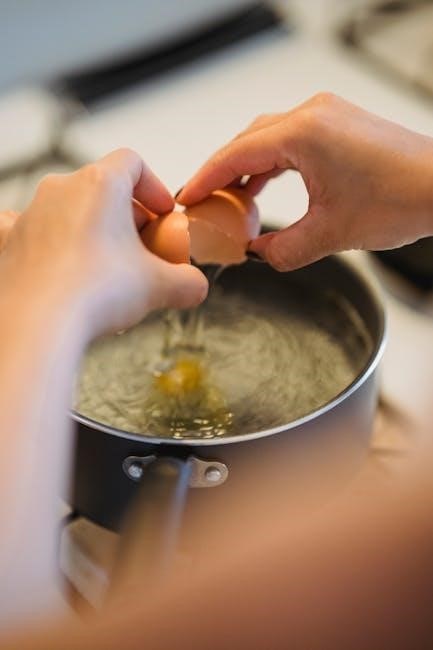
Care and Maintenance
Proper care involves rinsing with cold water and mild soap, avoiding hot water to prevent warping, and storing in a dry, protective case to maintain hygiene.
Cleaning the Mouthguard
Regular cleaning is essential for maintaining hygiene and longevity. Use mild soap and cold water, gently scrubbing with a toothbrush to remove plaque and bacteria. Avoid harsh chemicals or hot water, as they may damage the material. Rinse thoroughly to ensure no soap residue remains. For deeper cleaning, soak the mouthguard in a mixture of equal parts water and white vinegar for 10 minutes. After cleaning, rinse and dry thoroughly before storing. Proper cleaning prevents odor and bacterial buildup, ensuring comfort and safety during use.
Storing the Mouthguard Properly
Proper storage is crucial to maintain the mouthguard’s shape and hygiene. Always store it in a protective, ventilated case to prevent damage and bacterial growth. Keep it away from direct sunlight and extreme temperatures, as heat can warp the material. Avoid storing it in a damp environment to prevent mold. Clean the mouthguard before storing to ensure freshness. Store it separately from other gear to avoid accidental bending or compression. By following these steps, the mouthguard will remain in good condition and ready for use, ensuring long-lasting protection and comfort during activities.
Inspecting for Damage
Regularly inspect your mouthguard for signs of wear or damage. Examine it for cracks, tears, or thinning areas, which can compromise protection. Check if the material is still firm and retains its shape after boiling. Ensure the surface is smooth, with no sharp edges that could irritate gums or cheeks. If you notice any damage, consider replacing the mouthguard to maintain proper protection. Store it in a protective case when not in use to prevent accidental bending or stretching. A well-maintained mouthguard ensures optimal performance and safety during sports or activities.

Safety Precautions
Handle boiling water and mouthguards with care to avoid burns. Use tongs to submerge and remove the mouthguard. Ensure it’s not too hot before placing in your mouth.
Avoiding Overheating
Avoid overheating the mouthguard by monitoring water temperature closely. Use a food thermometer to ensure water reaches the recommended 160°F to 180°F. Never leave boiling water unattended. Overheating can cause the mouthguard to become misshapen or brittle, reducing its effectiveness. Once submerged, remove it as soon as it becomes pliable and loses its rigidity. Excessive heat exposure can damage the material, making it uncomfortable or less protective. Always follow the manufacturer’s guidelines for boiling time and temperature to prevent overheating and ensure a safe, proper fit.
Preventing Burns
Preventing burns is crucial when boiling a mouthguard. Always handle the mouthguard with tongs or a spoon to avoid direct contact with hot surfaces. After boiling, let the mouthguard cool slightly before placing it in your mouth. You can also run it under cold water for a few seconds to reduce its temperature. Never touch the mouthguard immediately after boiling, as it may remain extremely hot. Ensure the mouthguard is lukewarm before molding it to prevent burns and discomfort. Following these steps ensures a safe and effective fitting process.
Ensuring the Mouthguard is Not Too Hot
To ensure the mouthguard is not too hot, let it stand in the water for about 30 seconds after boiling. Use a slotted spoon to carefully remove it and gently shake off excess water. Before placing it in your mouth, test the temperature by lightly touching the mouthguard to your wrist. If it feels too hot, allow it to cool for another 10-15 seconds. Avoid rushing this step, as a mouthguard that is too hot can cause discomfort or burns. Proper cooling ensures a safe and comfortable molding process.
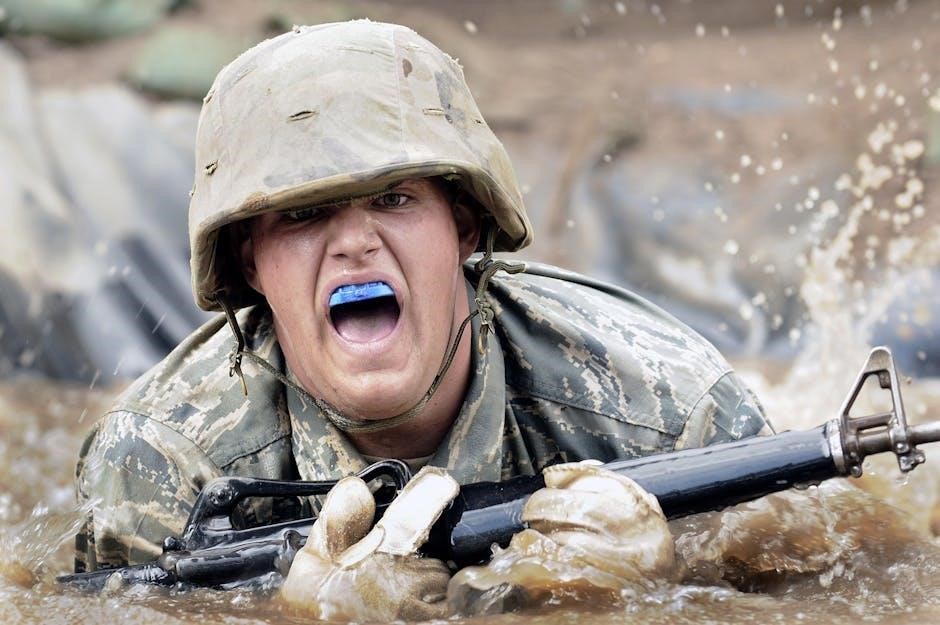
Troubleshooting Common Issues
Common issues when boiling a mouthguard include improper fit, discomfort, or mold retention. Adjusting water temperature, ensuring proper biting technique, and allowing adequate cooling can resolve these problems effectively.
What if the Mouthguard is Too Loose?
If the mouthguard feels too loose after boiling, it may not have molded properly or cooled long enough. Try re-boiling it for a slightly shorter time to avoid over-softening. After cooling, bite down gently to reshape it. If it still feels loose, ensure proper alignment with your teeth and gums. If issues persist, consult the manufacturer’s instructions or consider re-fitting the guard. Avoid over-adjusting, as this can lead to discomfort or uneven protection. Proper cooling and fitting are key to achieving a secure, comfortable fit.
What if the Mouthguard is Too Tight?
If the mouthguard feels too tight, it may cause discomfort or pain. This can occur if it cools too quickly or molds too snugly. To fix this, soak the mouthguard in warm water for a few minutes to soften it slightly. Gently stretch the areas that feel too tight, but avoid over-stretching, as this can loosen the fit. You can also use a hairdryer on a low setting to soften the material for minor adjustments. Ensure proper alignment and avoid forcing it into place, as this could cause further discomfort. Proper care and adjustments can improve comfort without compromising protection.
Fixing a Poor Fit
A poor fit can make the mouthguard uncomfortable or ineffective. If the mouthguard doesn’t mold properly, re-boil it and try again, ensuring the water isn’t too hot or cold. Use a spoon to gently reshape areas that feel uneven. Allow it to cool slightly before biting down to ensure proper alignment. Avoid over-adjusting, as this can weaken the material. If the fit remains unsatisfactory, consider consulting a professional for a custom solution. Proper shaping is essential for both comfort and protection, so take your time and follow the manufacturer’s guidelines carefully to achieve the best results.
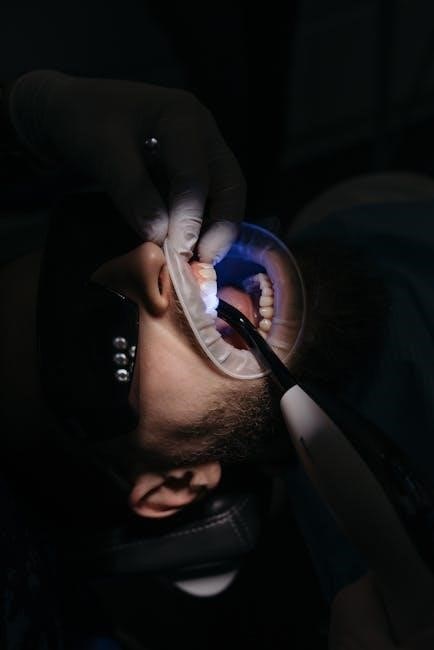
Special Considerations
Special considerations include boiling mouthguards for children, sensitive teeth, or those with straps, ensuring a comfortable and secure fit for all users.
Boiling Mouthguards for Children
Boiling mouthguards for children requires extra care to ensure safety and proper fit. Always supervise children during the process to prevent burns. Use a thermometer to ensure water isn’t overly hot. After boiling, carefully trim any excess material to avoid irritation. The mouthguard should fit snugly but comfortably, allowing for proper breathing and speaking. If the child has sensitive gums or teeth, consider a youth-sized mouthguard designed for smaller mouths. Ensure the child is present during the molding process to achieve the best fit. Never leave boiling water unattended near children.
Boiling Mouthguards for Sensitive Teeth
Boiling mouthguards for individuals with sensitive teeth requires careful attention to avoid discomfort. Use water at a slightly lower temperature to prevent overheating. Avoid biting down too hard, as this can cause pressure on sensitive areas. After boiling, allow the mouthguard to cool slightly before molding to reduce irritation. Ensure the fit is snug but not overly tight, as this can exacerbate sensitivity. If discomfort persists, consider using a mouthguard specifically designed for sensitive teeth. Always follow the manufacturer’s guidelines to achieve the best results without compromising comfort.
Boiling Mouthguards with Straps
When boiling a mouthguard with a strap, ensure the strap is fully submerged in water to maintain flexibility. After boiling, carefully remove the mouthguard and let it cool slightly. Mold the guard to your teeth, then adjust the strap to fit securely around your mouth. Avoid stretching the strap too tightly, as this can cause discomfort. Allow the mouthguard to cool completely before re-boiling if adjustments are needed. Ensure the strap aligns properly with your mouth for optimal protection and comfort. Always follow the manufacturer’s instructions for specific guidance on handling mouthguards with straps.
Boiling a mouthguard is a simple process that ensures a proper fit and optimal protection. Always follow instructions carefully to achieve the best results and safety.
Boiling a mouthguard involves heating water, submerging the guard, and letting it sit before molding it in the mouth. Proper timing ensures the material softens without overheating. After boiling, immediately place the guard in your mouth and bite down gently to shape it to your teeth and gums. Hold the position until it cools slightly to set the mold. Allow it to cool completely for a snug, protective fit. Follow all steps carefully to ensure effectiveness and safety.
Final Tips for Success
For a successful boil-and-bite experience, always follow the manufacturer’s instructions precisely. Ensure water reaches the recommended temperature to avoid underheating or overheating the mouthguard. Be patient during the cooling phase, as rushing can lead to improper shaping. Handle the mouthguard gently to prevent stretching or distorting the material. Practice proper hygiene by cleaning the guard before and after use. Store it in a protective case when not in use to maintain its shape. Regularly inspect for wear and tear to ensure optimal protection and comfort during activities.
Importance of Following Instructions
Adhering to the manufacturer’s guidelines ensures a safe and effective fitting process. Deviating from instructions can result in improper shaping, reduced protection, or even damage to the mouthguard. Correct steps guarantee the material softens evenly, allowing for a precise mold of your teeth and gums. This ensures optimal comfort and protection during sports or activities; Always prioritize the recommended boiling time and temperature to avoid overheating, which can render the mouthguard unusable. Following instructions carefully is crucial for achieving a professional-grade fit without the need for costly adjustments.
